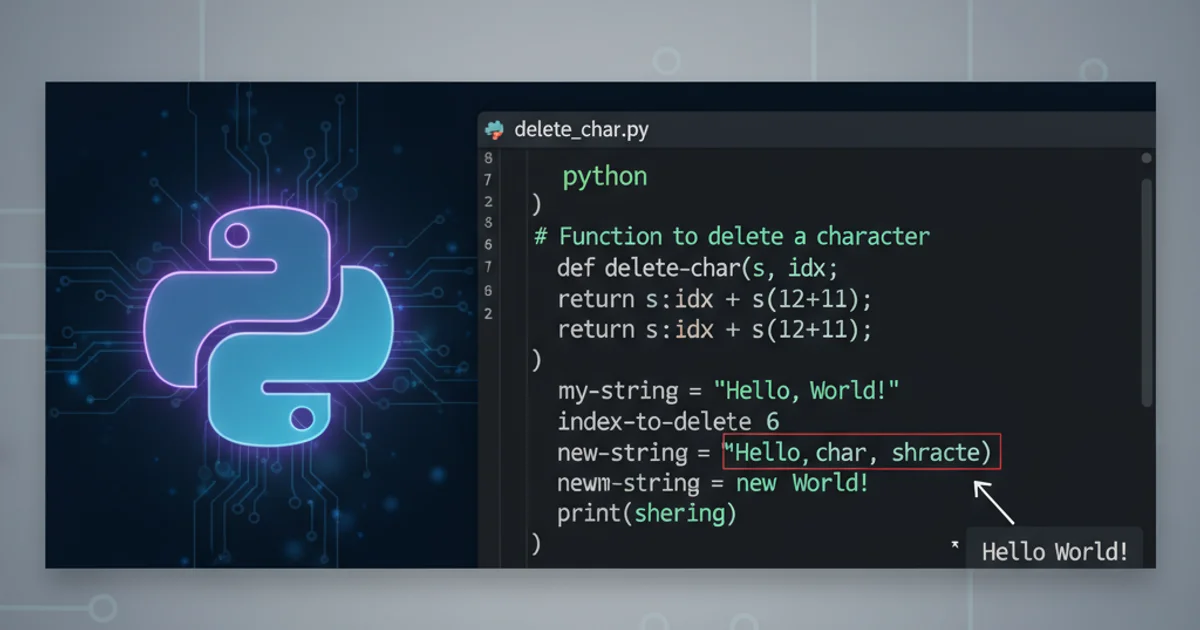How to delete a character from a string using Python
Categories:
How to Delete a Character from a String in Python

Learn various Python methods to remove specific characters or characters at certain positions from strings, enhancing your string manipulation skills.
Python strings are immutable, meaning once created, their content cannot be changed directly. To 'delete' a character, you actually create a new string that excludes the desired character(s). This article explores several common and efficient techniques to achieve this, from removing characters by value to deleting them by index.
Method 1: Using replace() for Specific Characters
The replace() method is the most straightforward way to remove all occurrences of a specific character or substring from a string. It returns a new string with all instances of the old substring replaced by the new substring. To 'delete' a character, you replace it with an empty string ''.
original_string = "Hello, World!"
char_to_remove = ","
new_string = original_string.replace(char_to_remove, "")
print(new_string)
# Removing multiple occurrences
original_string_2 = "banana"
char_to_remove_2 = "a"
new_string_2 = original_string_2.replace(char_to_remove_2, "")
print(new_string_2)
Using replace() to remove specific characters.
replace() method can also take an optional third argument, count, to specify how many occurrences to replace. For example, my_string.replace('a', '', 1) would only remove the first 'a'.Method 2: Slicing for Deleting by Index
When you need to remove a character at a specific position (index), string slicing is an efficient and Pythonic approach. You can construct a new string by concatenating slices of the original string, omitting the character at the target index.
original_string = "Python"
index_to_remove = 2 # Remove 't'
# Check if index is valid
if 0 <= index_to_remove < len(original_string):
new_string = original_string[:index_to_remove] + original_string[index_to_remove+1:]
print(new_string)
else:
print("Index out of bounds")
original_string_2 = "example"
index_to_remove_2 = 0 # Remove 'e'
new_string_2 = original_string_2[:index_to_remove_2] + original_string_2[index_to_remove_2+1:]
print(new_string_2)
Removing a character by its index using string slicing.
flowchart TD
A[Start] --> B{Identify Character/Index to Remove}
B -->|Remove by Value| C[Use `replace()` method]
C --> D[Specify character to replace with empty string]
D --> E[New string created without specified character]
B -->|Remove by Index| F[Use string slicing]
F --> G[Create slice before index]
G --> H[Create slice after index]
H --> I[Concatenate slices]
I --> E
E --> J[End]Decision flow for choosing a character removal method.
Method 3: Using join() with a Generator Expression or List Comprehension
For more complex filtering, such as removing multiple specific characters or characters based on a condition, join() combined with a generator expression or list comprehension offers a flexible solution. This method iterates through the string, includes only the characters that meet a certain condition, and then joins them back into a new string.
original_string = "Hello, World!"
chars_to_remove = {',', 'o', ' '}
# Using a generator expression
new_string_gen = "".join(char for char in original_string if char not in chars_to_remove)
print(new_string_gen)
# Using a list comprehension
new_string_list = "".join([char for char in original_string if char not in chars_to_remove])
print(new_string_list)
# Removing digits
text_with_digits = "abc123def456"
new_text = "".join(char for char in text_with_digits if not char.isdigit())
print(new_text)
Removing multiple characters or characters based on a condition.
join() with a generator/list comprehension is powerful, it can be less performant than replace() for simple, single-character removals, especially on very long strings, due to the overhead of iteration and conditional checks.Method 4: Using translate() and str.maketrans() for Multiple Character Replacements
The str.translate() method, in conjunction with str.maketrans(), is highly efficient for replacing or deleting multiple characters in a single pass. str.maketrans() creates a mapping table, and translate() uses this table to perform the replacements. To delete characters, you map them to None.
original_string = "Hello, World!"
chars_to_delete = ",!"
# Create a translation table where characters in chars_to_delete are mapped to None
translation_table = str.maketrans('', '', chars_to_delete)
# Apply the translation
new_string = original_string.translate(translation_table)
print(new_string)
# Example with both replacement and deletion
original_string_2 = "apple pie"
# Map 'a' to 'A', 'p' to 'P', and delete 'e'
translation_table_2 = str.maketrans('ap', 'AP', 'e')
new_string_2 = original_string_2.translate(translation_table_2)
print(new_string_2)
Using translate() and maketrans() for efficient multiple character deletion.
translate() method is particularly efficient for large strings and when you need to perform multiple character-level operations (replacements and deletions) simultaneously, as it avoids repeated string creation.